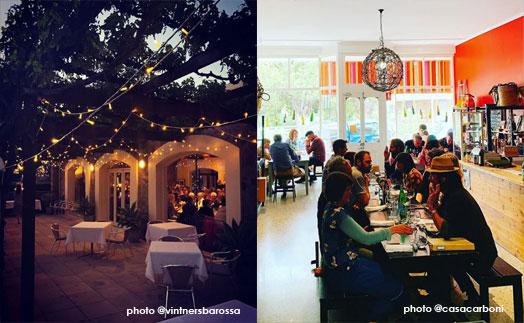To decant or not to decant…
by Jess Ruciack and Cameron Malouf
To decant or not to decant… this is a question we often receive at Elderton regarding our red wines.
Firstly, what is decanting?
It is the function of pouring a bottle of wine into another glass container and serves two main purposes: keeping sediment out of your glass, and aerating the wine.
Sediment – can form in older bottles of red wine, as the colour and tannins bind together and start to ‘drop out’ of the wine. Having these in your glass can result in some bitter flavours and a gritty texture in your mouth, so you can decant and keep the sediment in the bottle and away from the wine. You’ll need to decant very slowly and keep a close eye on the bottle to stop pouring as soon as you see sediment near the neck. You may lose a little bit of remaining wine, but this is a better result than tasting the sediment.
Aerating – Some, but definitely not all, wines need some time to ‘open up’. When oxygen is able to get in and around the wine, it starts to oxidise, which can make the wine seem more expressive and aromatic. It doesn’t change the tannin structure of the wine, but does allow some of the volatile compounds to evaporate, leaving the wine to appear more balanced and enjoyable.
You may also need to decant if you had a cork malfunction and don’t want bits of cork in your glass. This is where keeping a small sieve in the kitchen comes in handy.

So back to the question – To decant or not to decant?
The easy answer to this question is that there is no easy answer! However, here are a few pointers from Decanter Magazine that will hopefully get you going in the right direction:
• Generally speaking some aeration is better than none, although we do understand that you may be desperate for a drink!
• Simply opening a wine and leaving it in the bottle for a few hours will have little effect on the flavour of the wine.
• Younger wines should be decanted for a longer period (1 – 2 hours), and the process of decanting can be a touch rougher (you want the wine to receive oxygen to open it up).
• Older wines need to be decanted gently (to remove any potential sediment), and for a short amount of time < 1 hour only. Too much time and the wine may fall apart.
• Very rich wines can shed some of their puppy fat from longer decanting, but will lose some of their freshness.
• You cannot resuscitate a wine that is already past it through decanting.
Another great tip, learned through experience, is that you don’t need to spend lots of money on a decanter. Some are certainly gorgeous pieces of art (like the Riedel decanter my husband bought me a few years back), but something as simple as a jug or a conical flask can do the job. Your chemistry teacher didn’t give you that gem of advice though, did they?
For best drinking pleasure also, we here at Elderton recommend serving the wines at the correct drinking temperatures (something we often don’t do well in Australia). When we say cellar temperature we would ideally like our red wines served around 18 degrees Celsius.
Tips on decanting older wines
Once you have cellared your Elderton wines, we want you to enjoy them as wonderfully developed examples of fine wines. So we’ve chatted with one of our Cellar Door hosts, and self-confessed wine boffin, Cameron Malouf about his suggestions to get the best out of your vintage collection.
- Think ahead. Whenever possible, stand your bottle of wine up for 12 to 24 hours prior to opening. This allows any sediment to collect in the bottom of the bottle so that you can pour or decant with reduced risk of sediment in the glass.
- Open carefully! Older corks can become soft/brittle with age so a delicate approach will pay handsome dividends. Remove the foil of the wine and use the end of the corkscrew handle to push the cork into the neck of the bottle a millimetre or two. This action will not damage the cork, but it will free the cork from any friction bonds with the glass in the bottle opening.Once the cork is relaxed in this fashion, gently screw the corkscrew into the cork as far as possible. Slowly and gently remove the cork from the bottle. Should you accidentally push the cork into the bottle this is no issue at all though you may need to use a stainless-steel skewer or fork handle to keep the neck clear of the cork while pouring.
- If the cork crumbles into the wine do not panic. The presence of crumbled cork in a wine does not make it corked. Pouring through a fine stainless-steel gauze or fresh (unused) chux towel will filter the wine well enough to remove any offensive cork particles.
- To decant or not? Most wine benefits from decanting for a variety reasons. Older wines tend to build up flavours and aromas as they age, which are often perceived as quite unpleasant when a bottle is first opened. With gentle decanting, these compounds disappear harmlessly as they oxidise.As a general rule, younger wines can “breathe” for longer periods than older wines. Whilst the perfect time for decanting before consumption is not an exact science, our best advice is as you would taste your food during the preparation of a meal, so too should you taste your wine when it is first opened or decanted, and then in regular intervals to assess its progress and when it shows increased richness of flavour on the palate, then that is a good time to start pouring the wine.
Still confused? We’re here to help. Give us a call or drop us a line and we can help you with advice on any aspect of storing, cellaring and decanting of your wines.
As always though, it is each to their own
Don’t let this blog put you off – if you are happy drinking wines in a different manner, continue on.
Wine is an individual thing, and nothing upsets us more than wine snobbery. Basically, do what makes you happy – especially if it is drinking Elderton!
There is no ‘best wine’ – it is simply about what you enjoy drinking.
Also check out our Cellaring Chart to help guide you when to drink!
Cheers!
First published 22 April, 2016. Updated 27 January, 2022.


